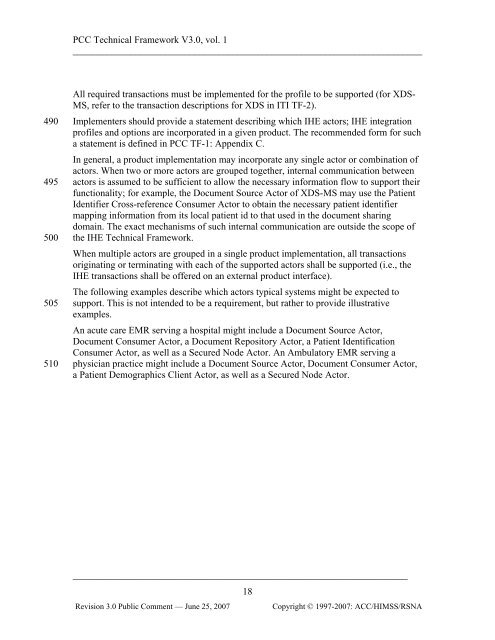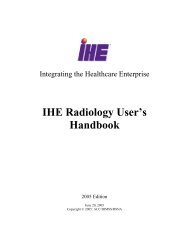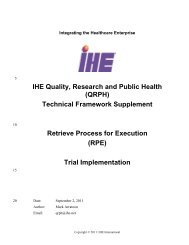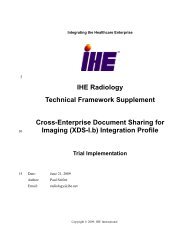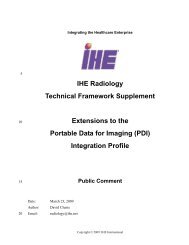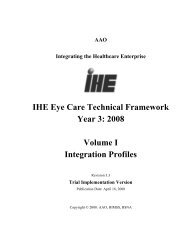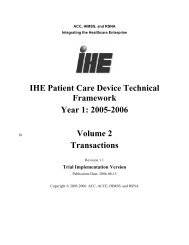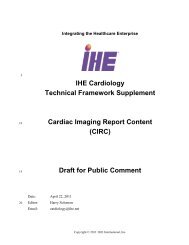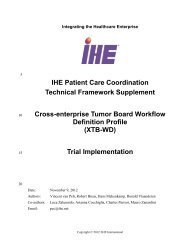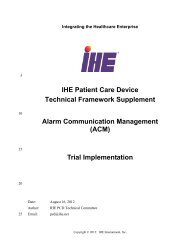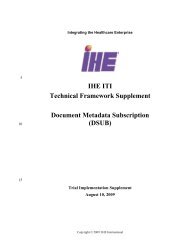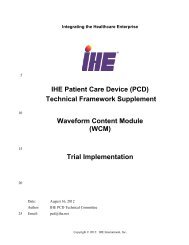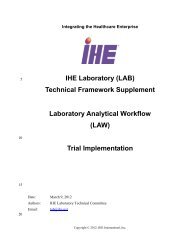IHE Patient Care Coordination Technical Framework Vol I
IHE Patient Care Coordination Technical Framework Vol I
IHE Patient Care Coordination Technical Framework Vol I
You also want an ePaper? Increase the reach of your titles
YUMPU automatically turns print PDFs into web optimized ePapers that Google loves.
PCC <strong>Technical</strong> <strong>Framework</strong> V3.0, vol. 1<br />
________________________________________________________________________<br />
490<br />
495<br />
500<br />
505<br />
510<br />
All required transactions must be implemented for the profile to be supported (for XDS-<br />
MS, refer to the transaction descriptions for XDS in ITI TF-2).<br />
Implementers should provide a statement describing which <strong>IHE</strong> actors; <strong>IHE</strong> integration<br />
profiles and options are incorporated in a given product. The recommended form for such<br />
a statement is defined in PCC TF-1: Appendix C.<br />
In general, a product implementation may incorporate any single actor or combination of<br />
actors. When two or more actors are grouped together, internal communication between<br />
actors is assumed to be sufficient to allow the necessary information flow to support their<br />
functionality; for example, the Document Source Actor of XDS-MS may use the <strong>Patient</strong><br />
Identifier Cross-reference Consumer Actor to obtain the necessary patient identifier<br />
mapping information from its local patient id to that used in the document sharing<br />
domain. The exact mechanisms of such internal communication are outside the scope of<br />
the <strong>IHE</strong> <strong>Technical</strong> <strong>Framework</strong>.<br />
When multiple actors are grouped in a single product implementation, all transactions<br />
originating or terminating with each of the supported actors shall be supported (i.e., the<br />
<strong>IHE</strong> transactions shall be offered on an external product interface).<br />
The following examples describe which actors typical systems might be expected to<br />
support. This is not intended to be a requirement, but rather to provide illustrative<br />
examples.<br />
An acute care EMR serving a hospital might include a Document Source Actor,<br />
Document Consumer Actor, a Document Repository Actor, a <strong>Patient</strong> Identification<br />
Consumer Actor, as well as a Secured Node Actor. An Ambulatory EMR serving a<br />
physician practice might include a Document Source Actor, Document Consumer Actor,<br />
a <strong>Patient</strong> Demographics Client Actor, as well as a Secured Node Actor.<br />
_____________________________________________________________________<br />
18<br />
Revision 3.0 Public Comment — June 25, 2007<br />
Copyright © 1997-2007: ACC/HIMSS/RSNA


